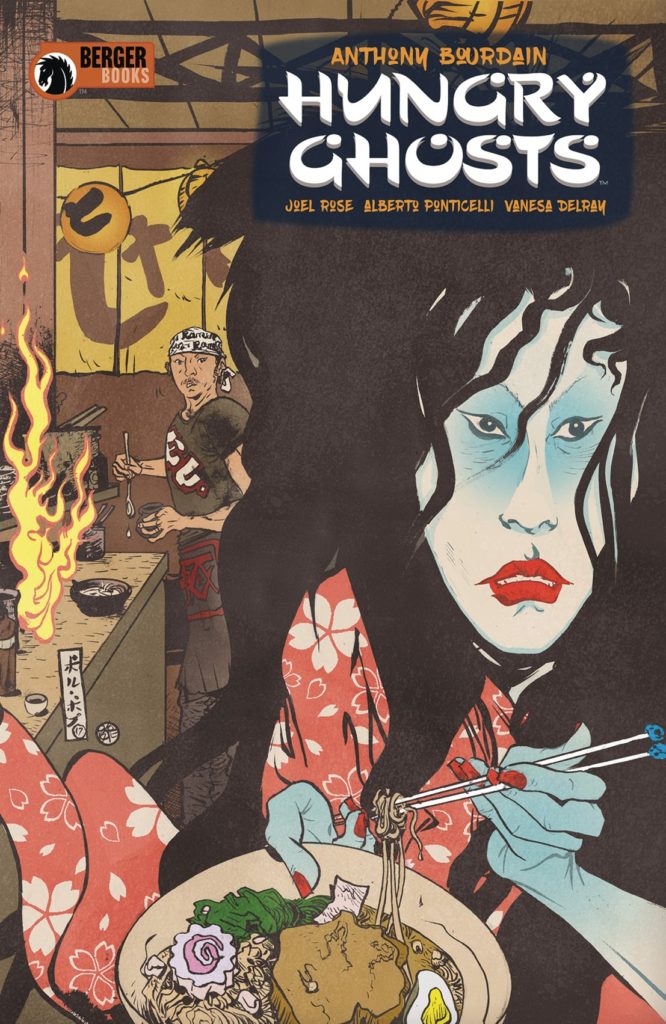There was always that element of surprise and awe in travelling with the towering Anthony Bourdain as the legendary celebrity chef & author ventured into unknown places around the nook and corners of the planet savouring unfamiliar gastronomical delights. Indeed some of the episodes were barbarous and revolting but it was Bourdain’s elucidation of the cuisine and the culture that made the show absorbing. Personally, I wasn’t the strictest follower of Bourdain’s sojourns except when ‘The Layover’ debuted on Netflix, which I binged upon, if not for the food the show was an interesting exploration of the places one might visit.

But just like his stunning TV shows where he surprised the audiences with local delicacies I was enthralled to read about a graphic novel, the ‘Hungry Ghosts’, that he co-authored with Joel Rose. It’s a terrifying piece, and if I may add, graphically explicit in its textual content and colour set in mostly Japanese storytelling. Inspired by the Japanese Edo period parlour game of Hyakumonogatari Kaidankai, it reimagines the classic stories of yokai, yorei, and obake with, of course, the centrepiece of the narrative being food. According to Wikipedia, a ‘Hungry Ghost’ “is a concept in Chinese Buddhism, Chinese traditional religion, Vietnamese Buddhism and Vietnamese traditional religion representing beings who are driven by intense emotional needs in an animalistic way.”, in Hinduism the term they use is preta, and that is evidently showcased in the graphic novel. Incidentally, I haven’t written about graphic novels since I finished the Watchmen in 2010 but this book somehow inspired me to write once again.
During this period of reading ‘Hungry Ghosts’, I came across the gaming concept of Hyakumonogatari Kaidankai or a Gathering of One Hundred Supernatural Tales:
The game was played as night fell upon the region using three separate rooms. In preparation, participants would light 100 andon (candles) in the third room and position a single mirror on the surface of a small table. When the sky was at its darkest, guests gathered in the first of the three rooms, taking turns orating tales of ghoulish encounters and reciting folkloric tales passed on by villagers who claimed to have experienced supernatural encounters. These tales soon became known as kaidan. Upon the end of each kaidan, the story-teller would enter the third room and extinguished one andon, look in the mirror and make their way back to the first room. With each passing tale, the room slowly grew darker and darker as the participants reached the one hundredth tale, creating a safe haven for the evocation of spirits. However, as the game reached the ninety-ninth tale, many participants would stop, fearful of invoking the spirits they had been summoning.
Wikipedia – https://en.wikipedia.org/wiki/Hyakumonogatari_Kaidankai
There are a total of 9 chilling stories that relate to the trappings of gluttony, greed, passion and hunger, and illustrated by a slew of talented designers, namely, Alberto Ponticello, Vanesa Del Rey, Leonardo Manco, Mateus Santolouco, Sebastian Cabrol, Paul Pope, Irene Koh, and Francesco Francavilla, who have used their creativity in drawing the ghoulish characters and breathing life into the storyline. It begins with a chilling tale of ‘The Starving Skeleton’ and a ramen shop owner who refuses to serve a famished beggar because he’s closing for the day and pays a heavy price for his actions. Through ‘The Pirates’, a band of pirates resort to a bargaining spree on a ship after they save a seductive woman from drowning in the high seas, what follows is truly unimaginable. Then, in the gruesome tale ‘Deep’ an Asian chef comes to the rescue of a young chef from his torturous and vile sous chef, but he turns out to be a Kappa who’s only desire is to taste the Shirikodama, the less said the better here. Brrrr! Despite the shortish length of the stories they make up for a gripping saga of horror, and if you can gather there’s a subtle gist in the messaging of the traditional stories to introspect and not lose control on one’s abilities and inner desires.
Now, as I mentioned there are 9 stories in a single collection, but in reality, it’s just a single story running throughout! Confused? That’s the thrilling part of Anthony Bourdain’s ‘Hungry Ghosts’ and the Hyakumonogatari Kaidankai storytelling. If you want to know more this article speaks about how the book came into fruition, and now it’s time for me to explore some of Tony’s other literary works!


